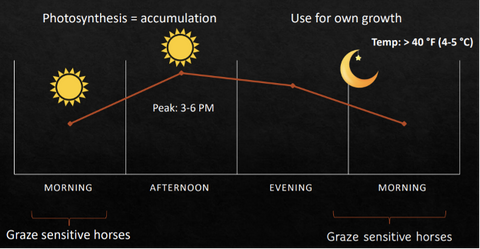Spring is coming! That means that horses can spend more time outdoors, and more time at pasture. When transitioning from stable to pasture, your horse’s diet changes too. More fresh spring grass. Did you know that grass produces fructan as a source of energy? In principle, normal quantities of fructan are not a risk for healthy horses. However, fructan can cause horses that are sensitive to sugar to suffer considerably. In this blog, we’re going to talk about all the things you should watch out for when your horse is turned out to pasture once more!
Fructan, the energy source of the grass plant
Grass naturally contains fructan. At certain times, mainly in spring and autumn, but also at certain times of day, the fructan content of grass is quite high. Grass obtains energy for growth from non-structural carbohydrates. Depending on the type of grass, these non-structural carbohydrates are stored in the grass plant as starch and fructan. The grass plant uses fructan as its energy source for growth. The plant stores fructan during the day and grows at night. When the nights remain relatively warm (+4-5 °C), the plant grows. However, if the temperatures are lower than 4-5 °C, it is too cold for the plant to grow and it saves the fructan it has stored so that it can grow when the weather becomes warmer.
Good pasture management avoids high sugar content
Fructan usually accumulates in the lower part of the grass plant, just above the ground. Grass that is rather short (for example due to overgrazing) is therefore not ideal. When mowing the grass, care should be taken to ensure that it is not cut too short. Mowing stimulates grass growth. This means that the fructan is not stored, but is used for growth.
Fructan, the villain
In principle, normal quantities of fructan are not a risk for healthy horses. However, fructan can cause horses that are sensitive to sugar to suffer considerably. It is only partially absorbed in the small intestine. The rest passes into the large intestine, where it is fermented by bacteria. One of the by-products of this fermentation is lactic acid. Large amounts of lactic acid reduce the pH of the large intestine. This causes all kinds of problems, mainly harmful to the good bacteria, and these in turn can cause laminitis. However, colic and diarrhoea are also potential problems.
In normal quantities fructan is not a risk
When is the best time for horses which are sensitive to sugar to be turned out?
Figure 1 shows how fructan levels fluctuate throughout the day. This is when the night-time temperatures do not fall below 4-5 °C. Horses which are sensitive to sugar, and therefore fructan, are best turned out in the morning when it has been between 4 and 5 °C overnight.

Figure 2 shows the fluctuations once again, but this time for night-time temperatures below 4-5 °C. It is best not to turn out horses which are sensitive to fructan during this period. A sand paddock is a better solution for these horses.

You can prevent many problems by getting the horse used to the transition gradually. To start with, only turn your horse out for short periods, increasing the time gradually if desired. Sensitive horses can benefit from turnout at specific times, when the fructan content of the grass is lowest.




